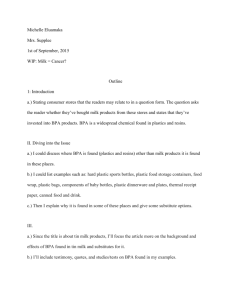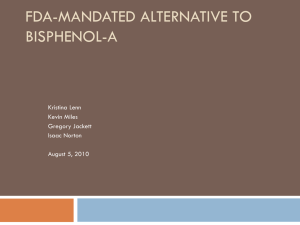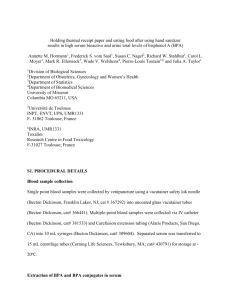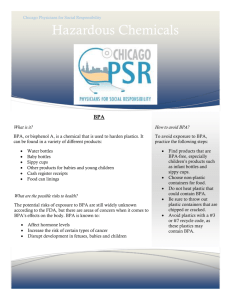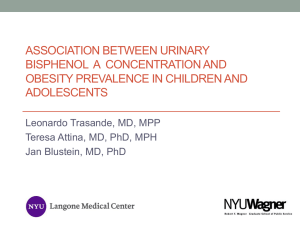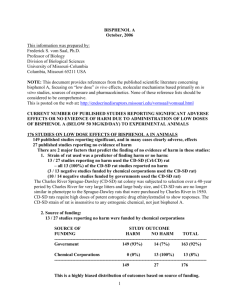abstract - Journal of Pharmaceutical Science and Bioscientific
advertisement
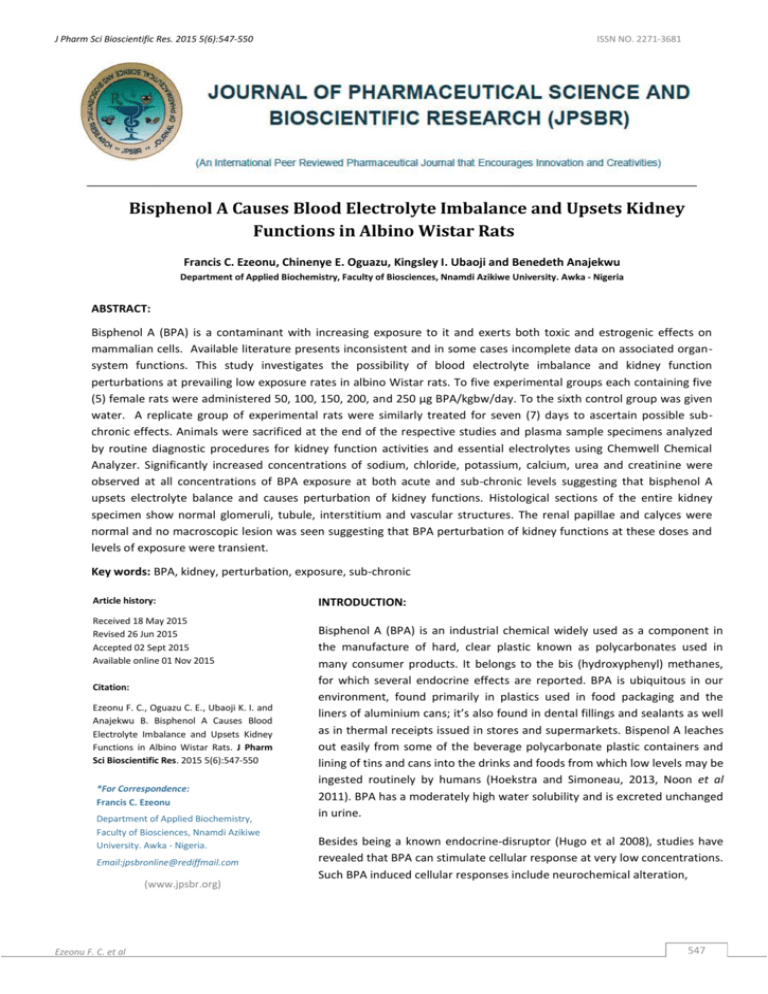
J Pharm Sci Bioscientific Res. 2015 5(6):547-550 ISSN NO. 2271-3681 Bisphenol A Causes Blood Electrolyte Imbalance and Upsets Kidney Functions in Albino Wistar Rats Francis C. Ezeonu, Chinenye E. Oguazu, Kingsley I. Ubaoji and Benedeth Anajekwu Department of Applied Biochemistry, Faculty of Biosciences, Nnamdi Azikiwe University. Awka - Nigeria ABSTRACT: Bisphenol A (BPA) is a contaminant with increasing exposure to it and exerts both toxic and estrogenic effects on mammalian cells. Available literature presents inconsistent and in some cases incomplete data on associated organsystem functions. This study investigates the possibility of blood electrolyte imbalance and kidney function perturbations at prevailing low exposure rates in albino Wistar rats. To five experimental groups each containing five (5) female rats were administered 50, 100, 150, 200, and 250 μg BPA/kgbw/day. To the sixth control group was given water. A replicate group of experimental rats were similarly treated for seven (7) days to ascertain possible subchronic effects. Animals were sacrificed at the end of the respective studies and plasma sample specimens analyzed by routine diagnostic procedures for kidney function activities and essential electrolytes using Chemwell Chemical Analyzer. Significantly increased concentrations of sodium, chloride, potassium, calcium, urea and creatinine were observed at all concentrations of BPA exposure at both acute and sub-chronic levels suggesting that bisphenol A upsets electrolyte balance and causes perturbation of kidney functions. Histological sections of the entire kidney specimen show normal glomeruli, tubule, interstitium and vascular structures. The renal papillae and calyces were normal and no macroscopic lesion was seen suggesting that BPA perturbation of kidney functions at these doses and levels of exposure were transient. Key words: BPA, kidney, perturbation, exposure, sub-chronic Article history: Received 18 May 2015 Revised 26 Jun 2015 Accepted 02 Sept 2015 Available online 01 Nov 2015 Citation: Ezeonu F. C., Oguazu C. E., Ubaoji K. I. and Anajekwu B. Bisphenol A Causes Blood Electrolyte Imbalance and Upsets Kidney Functions in Albino Wistar Rats. J Pharm Sci Bioscientific Res. 2015 5(6):547-550 *For Correspondence: Francis C. Ezeonu Department of Applied Biochemistry, Faculty of Biosciences, Nnamdi Azikiwe University. Awka - Nigeria. Email:jpsbronline@rediffmail.com (www.jpsbr.org) Ezeonu F. C. et al INTRODUCTION: Bisphenol A (BPA) is an industrial chemical widely used as a component in the manufacture of hard, clear plastic known as polycarbonates used in many consumer products. It belongs to the bis (hydroxyphenyl) methanes, for which several endocrine effects are reported. BPA is ubiquitous in our environment, found primarily in plastics used in food packaging and the liners of aluminium cans; it’s also found in dental fillings and sealants as well as in thermal receipts issued in stores and supermarkets. Bispenol A leaches out easily from some of the beverage polycarbonate plastic containers and lining of tins and cans into the drinks and foods from which low levels may be ingested routinely by humans (Hoekstra and Simoneau, 2013, Noon et al 2011). BPA has a moderately high water solubility and is excreted unchanged in urine. Besides being a known endocrine-disruptor (Hugo et al 2008), studies have revealed that BPA can stimulate cellular response at very low concentrations. Such BPA induced cellular responses include neurochemical alteration, 547 J Pharm Sci Bioscientific Res. 2015 5(6):547-550 abnormalities in sperm and oocyte maturation, disruption of fertility, changes in growth rate and immune dysfunctions (Richter et al 2007). The goal of this study is to investigate BPA activity induced changes in electrolyte balance and kidney function. ISSN NO. 2271-3681 Biotechnology (SAE) Cairo Egypt. Individual tests were carried out according to the kit specifications Differences between obtained values (mean ± SD) were carried out by one-way analysis of variance (ANOVA) using SPSS software version 17.0 followed by the TukeyKramer multiple comparison test. A P≤0.05 was taken as a criterion for a statistically significant difference. MATERIALS AND METHODS The second groups of experimental rats were similarly treated like the previous group except that treatment was sustained daily for seven (7) days to ascertain subchronic effects. Animals were housed in aluminum wiremesh cages in a well-ventilated animal house with a 12 h dark/light cycle and at room temperature and were provided commercial rat pellets (Vital feed from Vital group of Company, Nigeria) and water ad libitum. RESULTS The effects of exposure to various doses of BPA on essential electrolytes, creatinine and urea are shown in figures 1 and 2. Except for the 100µg and 150 µg BPA doses, significant increase in sodium was observed in BPA treated rats at both acute and sub chronic exposure phases (See figs. 1(a) & 1(b)). The same figures reveal a significant increase in chloride concentrations at 50, 200 and 250 µg BPA doses at acute exposure. Conversely, a dose dependent decrease in chloride was observed at sub chronic exposure doses except for the 250 µg BPA dose groups. Significant increase in creatinine was observed in treated rats at both acute and sub-chronic dose levels. Mean Values (mmol/L) Acute phase 350 300 250 200 150 100 50 0 SODIUM CHLORIDE control 50 100 150 200 250 250 200 150 100 50 0 SODIUN At the end of the experiments essential blood electrolytes and kidney function were assayed using Chemwell 2910 Auotanalyser. All reagents were commercially obtained as already prepared kits. The kits for calcium, sodium, potassium, chloride, urea, and creatinine were purchased from Egyptian company for Ezeonu F. C. et al CREATININE Dose (µgBPA/Kgbw) Sub-chronic phase Mean Values (mmol/L) Seventy two (72) non-pregnant female rats of age 9 weeks were acclimatized in the laboratory for seven days and randomly divided into two equal groups of 36 rats each. Each group was further subdivided into six experimental groups each containing six (6) rats and respectively administered 50, 100, 150, 200, and 250 μg BPA/kgbw/day. The sixth group which served as control did not receive any treatment but double distilled water instead. The respective concentrations of BPA were dissolved in double distilled water and administered by oral gavage using intubation canular. Blood were obtained from the first groups by cardiac puncture one hour after BPA administration and the animals sacrificed by suffocation with formalin soaked in cotton wool in a glass jar. Animals were subsequently dissected and their kidney obtained for histological analysis. Blood samples were processed for clinical assay while the kidney were fixed in 10% neutral formalin, trimmed and dehydrated in a series of graded ethanol concentrations, cleared in xylene and embedded in paraffin wax. Thin sections of 45 microns thick were made using a rotary microtone and stained with haematoxylin and eosin for light microscope. The slides were viewed at x400 objective lens, photomicrographed and the cell architecture interpreted by an expert histologist. CHLORIDE control 50 100 150 CREATININE Dose (µgBPA/Kgbw) 200 250 Fig 1. Serum sodium, chloride and creatinine profile of rats treated with BPA at (a) acute and (b) sub chronic doses. 548 J Pharm Sci Bioscientific Res. 2015 5(6):547-550 Potassium exhibited a significantly inverse relationship being high at acute phase and significantly lower at sub chronic phase. The effect of treatment on urea is inconsistent while a dose dependent increase was observed in calcium at acute phase. Analysis of significantly statistical data by post-hoc confirmed that the BPA exposed groups had a significant difference in the parameters tested at different doses, when compared with the control at p<0.05. Acute phase Mean Values (mmol/L) 20 15 10 5 0 -5 POTASSIUM control UREA 50 100 150 CALCIUM Dose (µgBPA/Kgbw) 200 250 Mean Values (mmol/L) Sub-chronic phase 8 6 4 2 0 UREA 150µgBPA/kg was not significant. Tyl et al. (2002) reported decreased sodium levels at the low-dose group. At acute level significantly high chloride ion was observed but at sub-chronic exposure chloride was low at all exposure doses except for 250µgBPA/kg where it was found to be high. These results are supported by earlier findings of Yamasaki et al (2002) who reported increased chloride ion in male rats exposed to BPA while Tyl et al. (2002) reported decreased chloride levels in the low-dose group in female mice for 2 weeks of 5000 ppm of BPA. Potassium ion concentration was significantly high following acute administration. Decreased potassium ion concentration was observed at all dose levels after subchronic administration. Tyl et al. (2002) reported similar decreased potassium levels in the low-dose group in female mice for 2 weeks of 5000ppm of BPA. Calcium ion concentration was elevated at acute level while at subchronic level it is low except at 150µgBPA/kg and 200µgBPA/kg. Oral administration of BPA at acute and sub-chronic exposures caused elevation in serum creatinine content. Decrease in urea was observed at acute doses (except for 50µgBPA/kg and 200µgBPA/kg), and at sub-chronic doses also (except at 100µgBPA/kg and 200µgBPA/kg). 10 POTASSIUM ISSN NO. 2271-3681 CALCIUM Dose (µgBPA/Kgbw) control 50 100 150 200 250 Fig 2. Serum potassium, calcium and urea profile of rats treated with BPA at (a) acute and (b) sub chronic doses. The increased levels of serum creatinine following BPA administration might be due to reduced ability of the kidney to eliminate the toxic metabolic substances. Sangai and Verma (2012) reported that BPA treatment in mice for 30 days caused significant (p < 0.05) rise in creatinine content, and that the effect was dosedependent. You et al (2011) reported that urinary creatinine excretion significantly increased with decreasing renal function. Histologically, the kidneys of all exposed animals are microscopically normal. The overall picture is that BPA is actually a toxicant, it alters kidney functions and plasma electrolyte, following acute and sub-chronic exposure to the doses employed in the study. However there are no morphological changes to the kidney. Acknowledgement DISCUSSION Sodium was significantly high at acute and sub-chronic doses, the decreases observed at 100µgBPA/kg and Ezeonu F. C. et al The authors wish to acknowledge that the analytical aspect of this work was conducted at the Clinical laboratory of the Directorate of Security Services Medical Centre, Abuja. We are grateful for the permission to use their Chemwell 2910 Autoanalyser and for the supply of 549 J Pharm Sci Bioscientific Res. 2015 5(6):547-550 reagent kits. We are particularly grateful to Zakar H. Madaki for his technical assistance. ISSN NO. 2271-3681 6. Tyl R, Myers CB, Marr MC. (2002). Abbreviated one-generation study of dietary bisphenol A (BPA) s in CD-1 (Swiss) mice. Research Triangle Park, NC: RTI (sponsored by the Society of the Plastics Industry, Inc.). Report nr 65C.07036.312 References 1. 2. Hoekstra Eddo J. and Catherine Simoneau (2013). Release of bisphenol A from polycarbonate –a review. Critical Reviews in Food Sciences and Nutrition; 53(4): 386 - 402 7. Hugo ER, Brandebourg TD, Woo JG, Loftus J, Alexander, JW, Ben-Jonathan N. (2008). Bisphenol A at environmentally relevant doses inhibits adiponectin release from human adipose explants and adipocytes. Environmental Health Perspectives; 116: 1642–1647 Yamasaki K, Sawaki M, Noda S, Imatanaka N, and Takatsuki M. (2002). Subacute oral toxicity study of ethynylestradiol and bisphenol A, based on the draft protocol for the "Enhanced OECD Test Guideline no. 407". Arch Toxicol 76:65–74. 8. You L, Zhu X, Shrubsole MJ, Fan H, Chen J, Dong J, Hao CM, Dai Q.(2011): Renal Function, Bisphenol A, and Alkylphenols: Results from the National Health and Nutrition Examination Survey (NHANES 2003-2006). Environmental Health Perspectives 119(4), p 527-33 3. Noon Gregory O., Luke K Ackerman and Timothy H Begley. Concentration of bisphenol A in highly consumed canned foods on the U.S. Market. Journal of Agriculture and Food Chemistry, 2011; 59(13): 7178 – 7185 4. Richter CA, Birnbaum LS, Farabollini F, Newbold RR, Rubin BS, Talsness CE, Vandenbergh JG, Walser-Kuntz DR, Vom Saal FS (2007): In vivo effects of bisphenol A in laboratory rodent studies. Reprod. Toxicol; 24:199–224 5. Sangai NP, and Verma RJ. Quercetin ameliorates bsiphenol - induced toxicity in mice. Acta Poloniae Pharmaceutical n Drug Research, 2012; 69(3): 557563. Ezeonu F. C. et al 550

